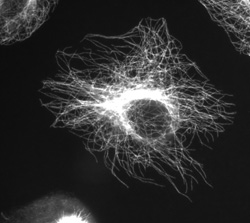 AUSTIN, Texas—Microtubules, essential structural elements in living cells, grow stiffer as they grow longer, an unexpected property that could lead to advances in nano-materials development, an international team of biophysicists has found.
AUSTIN, Texas—Microtubules, essential structural elements in living cells, grow stiffer as they grow longer, an unexpected property that could lead to advances in nano-materials development, an international team of biophysicists has found.
The team, from The University of Texas at Austin, the European Molecular Biology Laboratory (EMBL) in Heidelberg, Germany and Ludwig Maximilians University of Munich, reported their findings in Proceedings of the National Academy of Science on July 5.
“We found that the microtubules grow stiffer as they grow longer, a very unusual and surprising result,” said Ernst-Ludwig Florin, assistant professor with the Center of Nonlinear Dynamics at The University of Texas at Austin. “This will have a big impact on our understanding of how microtubules function in the cell and on advancing materials research.
“To my knowledge, no manmade material has this property—to become stiffer as it elongates,” said Florin. “This research could lead to the design of novel materials based on this biological structure.”
Microtubules, which are about 25 nanometers in diameter, play an essential role in many cellular processes, acting as girders of support for the cell and tracks along which organelles—structures in cells that perform specialized functions—can move. They are also essential components of flagella and cilia, the extensions of some cells that give them movement.
Florin and his colleagues measured the stiffness and length of cellular microtubules using a “single-particle tracking” technique. They attached yellow-green fluorescent beads to the tips of microtubules of various lengths and measured the position of the bead by analyzing frame-by-frame videos of the beads moving in solution. (The beads were 250 or 500 nanometers in diameter.)
The changes in the beads’ position were used to calculate the stiffness of the filaments they were attached to, through a method recently developed by the theoretical physicists on the research team.
To the surprise of the scientists, they found that the longer the filament, the more rigid it became.
Florin and his coauthors attribute the microtubules’ unique properties to their molecular architecture. The nanometer-sized filaments are hollow tubes made of tubulin proteins that bind to each other in ways that give them the ability to be both flexible and stiff.
Flexibility is important for microtubules as they grow and change in cells, while rigidity is important when cells need support.
“Microtubules are optimally designed to give the maximum of mechanical performance at a minimum cost for the cell,” said Francesco Pampaloni, a physical chemist at EMBL.
The new finding about the microtubules’ properties could provide insights into using the filaments as models for the development of nano-materials.
For more information contact Ernst-Ludwig Florin, 512-471-6441, florin@chaos.utexas.edu.

















Comments